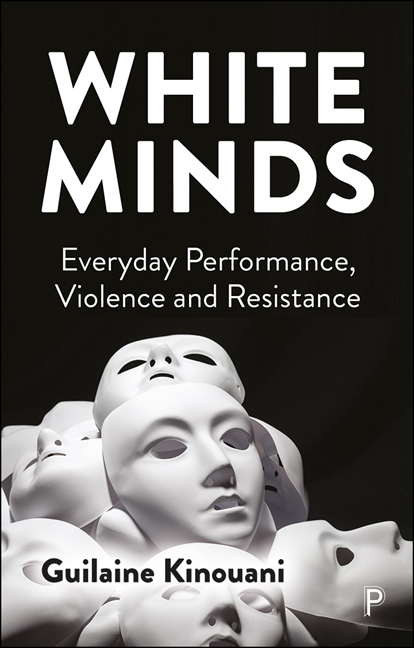Book contents
- Frontmatter
- Dedication
- Contents
- Acknowledgements
- Preface
- Note on language
- Introduction
- 1 Whiteness, time and space
- 2 White gazes
- 3 White envy
- 4 White sadism
- 5 White trauma
- 6 White dissociation
- 7 White shame
- 8 White ambivalence
- 9 White complicity
- Whiteness and resistance: by way of conclusion
- References
- Index
- Frontmatter
- Dedication
- Contents
- Acknowledgements
- Preface
- Note on language
- Introduction
- 1 Whiteness, time and space
- 2 White gazes
- 3 White envy
- 4 White sadism
- 5 White trauma
- 6 White dissociation
- 7 White shame
- 8 White ambivalence
- 9 White complicity
- Whiteness and resistance: by way of conclusion
- References
- Index
Summary
‘Look, a Negro!’
It was an external stimulus that flicked over me as I passed by.
I made a tight smile.
‘Look, a Negro!’
It was true. It amused me.
‘Look, a Negro!’
The circle was drawing a bit tighter. I made no secret of my amusement.
‘Mama, see the Negro! I’m frightened!’ Frightened! Frightened!
Now they were beginning to be afraid of me. I made up my mind to laugh myself to tears, but laughter had become impossible.
Now they were beginning to be afraid of me. I made up my mind I could no longer laugh, because I already knew that there were legends, stories, history, and above all historicity, which I had learned about from Jaspers.
(Fanon, 1952, p 84 [1])Although popularised by Lacan, it was another French intellectual, Sartre (in Being and nothingness), who formulated the impact of the gaze [2]. Specifically, Sartre put forth subjectivity’s entanglement with the perception of others, since what is perceived, including other people, is turned into objects by our gaze and becomes defined by the gazing subject [3].
Sartre sought to critique Descartes’ individualism in the formation of human subjectivity which he saw as distancing the subject from its relational context [4]. With his interrogation of the gaze, Sartre aimed to highlight the influence of the social on the subjective. Lacan further developed these ideas. Extending on from how infants relate to their reflection in mirrors, he proposed that during infancy we come to master a sense of self-awareness through the mirror [5]. Accordingly, human beings go through a process of acquiring self-representation through the reflected image they see of themselves in actual or symbolic mirrors usually; the gaze of others, and primarily that of their caregivers. This gaze allows the creation of a mental or ‘internal’ representation of an ‘I’ as the infant attempts to identify with the image which is projected onto them. Lacan later extended his theory from infancy to adulthood and set it as a theory of human subjectivity and identity. In summary, for Lacan, our subjectivity, our perceptions of our selfhood, are fundamentally relational since the mirror stage conceives our identity as contingent upon external objects.
In turn, Fanon elaborated on these formulations and applied them to the formation of subjectivity within the colonial situation. He did an unparalleled study of applying the Lacanian gaze to processes of racialisation.
- Type
- Chapter
- Information
- White MindsEveryday Performance, Violence and Resistance, pp. 36 - 51Publisher: Bristol University PressPrint publication year: 2023



